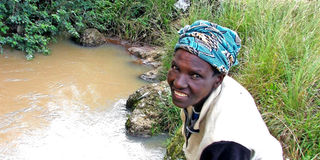Misplaced dump site exposes villagers to health risks

Nancy Wanjiku draws water for her cows from the contaminated Mathathi River, overlooking the Ol Kalou dumping site. PHOTO| WAIKWA MAINA,
Nancy Wanjiku, a resident of Mathathi Village, Nyandarua County has had to contend with a suffocating stench and swarms of flies for years.
She carefully balances a milking jug between her legs, milks with the right hand, and swats stubborn flies away with a fly whisk in her left hand, to keep them away from the cow’s eyes.
Six years into it, she has perfected the art of ensuring that no fly contaminates her milk or gets anywhere near her cow’s eyes. The stench, however, is now an unwelcome part of her life, come rain or shine, though it intensifies when it rains.
The only way out would be to sell her half-acre piece of land and relocate to a cleaner environment, but there are no takers.
“No one is willing to buy this land, not even at half price. They (rightly) say that this place is inhabitable,” says Ms Wanjiku, adding that they have to wait for the rains to collect clean drinking water, because Mathathi River, the only source of water for both Mathathi and Mahinga Villages, is polluted with garbage from the adjacent dump site and sewage from the nearby Ol Kalou town.
During the dry season when the garbage is set ablaze, the villages are engulfed in smoke, making life even more unbearable.
In the same village, 30-year-old Jackson Kamau has lost 11 dairy cows in five years. He only has four left, but they either don’t conceive, or they abort or deliver stillbirths. He thinks it has something to do with the dump site and polluted river.
Veterinary surgeon Dr Maina Kimindi says that the animal deaths might have been caused by environmental toxins from the poorly-disposed waste, but he doubts the environment has anything to do with the abortions and failure to conceive.
He says that those are likely caused by bacterial infections such as brucellosis.

Raw sewerage from the Ol Kalou sewerage treatment plant flowing to the river at Mathathi Village. PHOTO| WAIKWA MAINA
Improper waste disposal has affected three rivers: Raw sewerage flows into JM River, a dump site covers part of Mathathi River and brackish water from the dump site flows into Munyeki tributary which flows into Mathathi River.
The dump site is a stone’s throw away from the Nyandarua County Assembly, but that has not helped resolve the ticking time bomb.
When reached for comment, Nancy Muui, the National Environment Management Authority (Nema) county director for Nyandarua admitted that the site and sewerage treatment do not meet some recommended standards.
“There should be no waste disposed within a hundred metres of a river,” she said, and added that Nema was conducting a survey of all dumping sites in Nyandarua, after which they would recommend a way forward.
On his part, County Executive for Water and Environment Simon Ng’ang’a said that the county was planning to construct a modern sewerage treatment plant at a cost of Sh12 million, as a solution to the problem, and added that construction would begin in a month.
A day later, Nema and senior government officials banned the use of water from the two polluted rivers. They declared milk from cows that consume polluted water from the rivers unsafe, and cautioned that health effects from consuming the water would take up to 10 years to remedy.
In the meantime, the solid and liquid waste pollution continues unabated, and the villagers still don’t have a source of clean drinking water for themselves and their animals.

